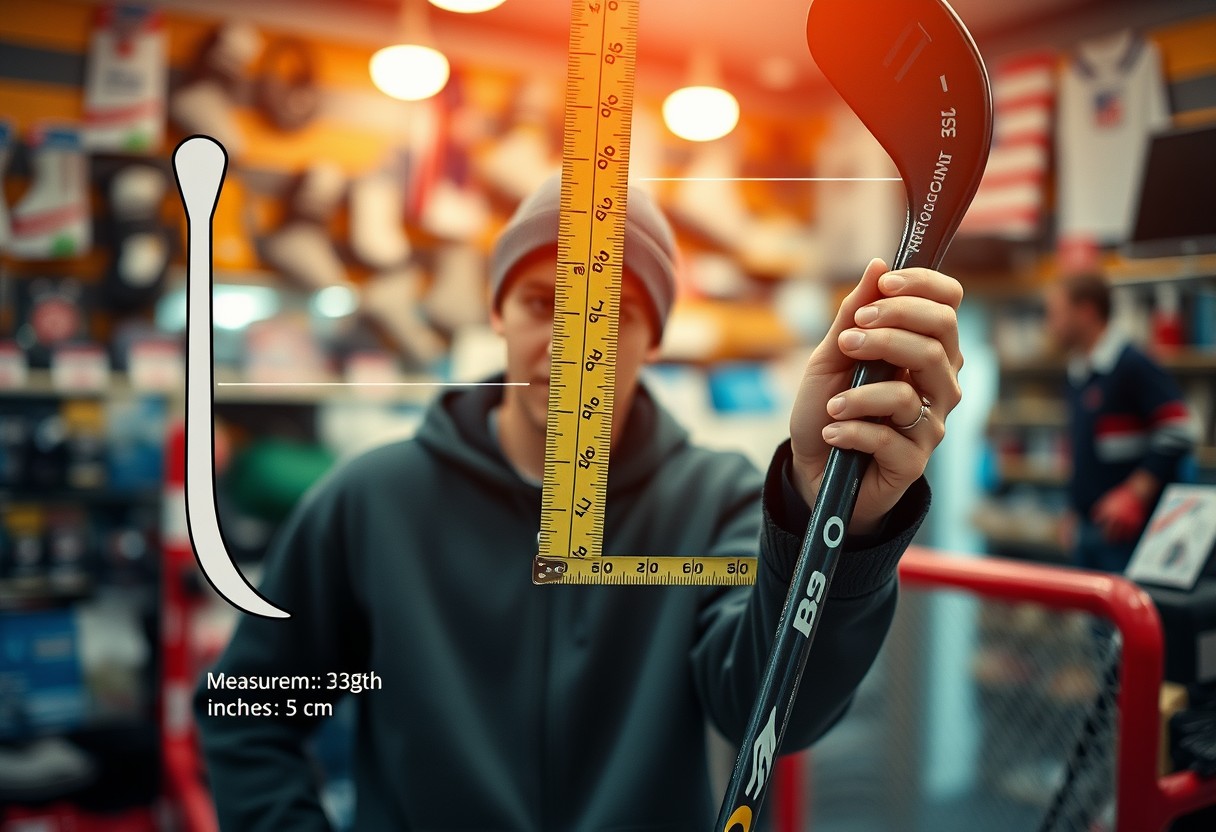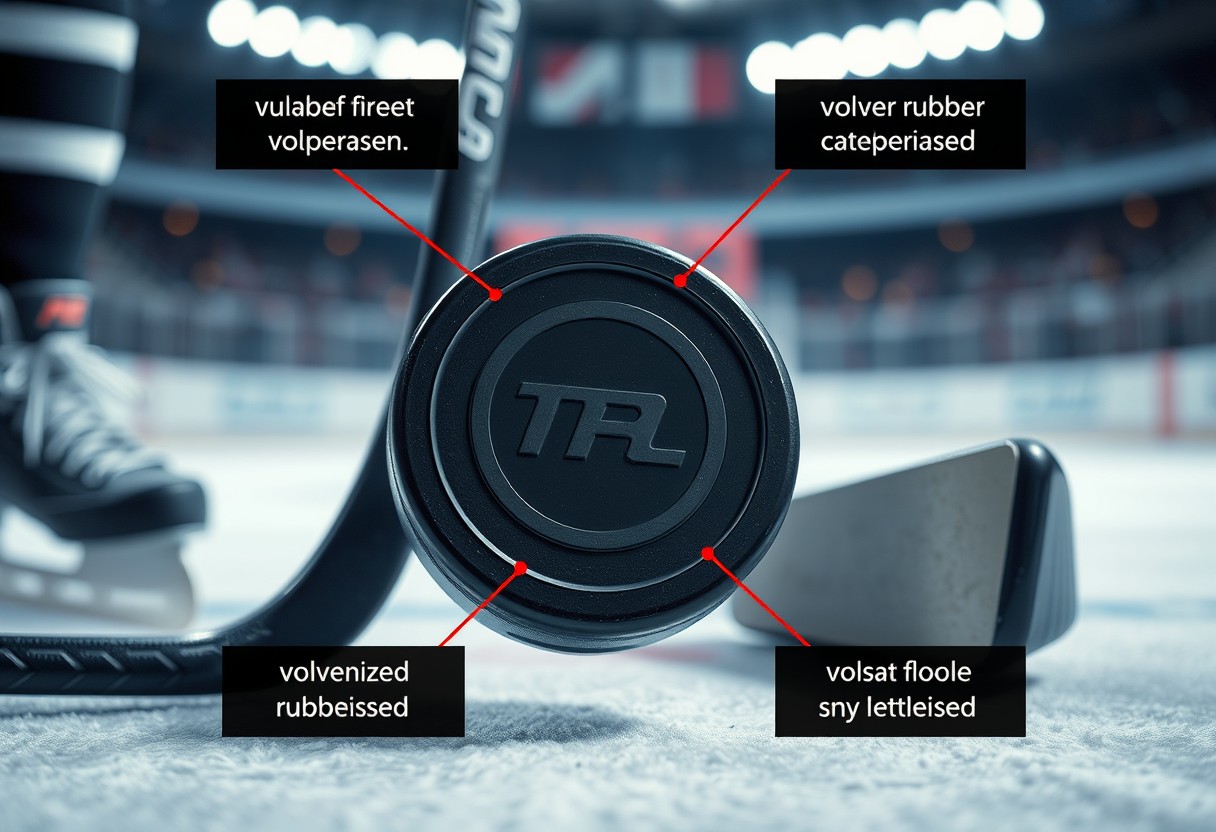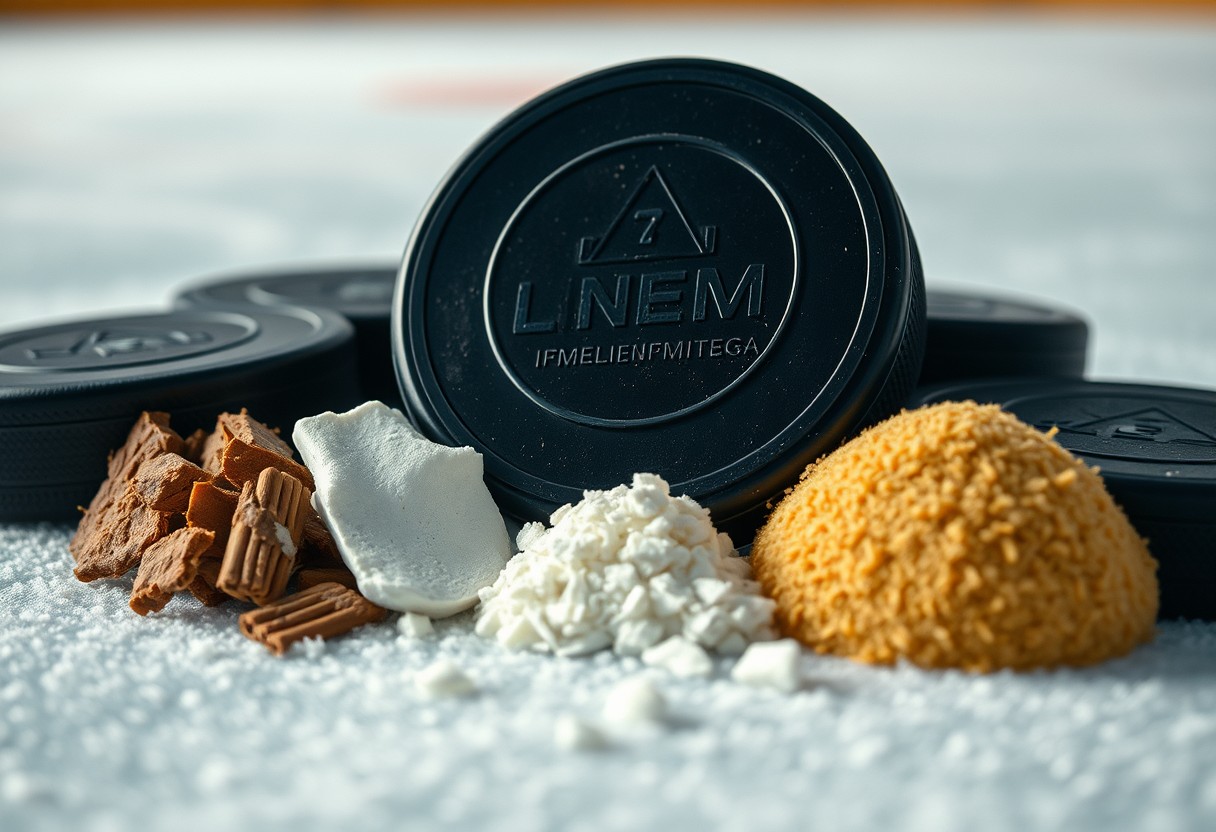Most hockey players underestimate the importance of choosing the right stick length, which can significantly impact your performance on the ice. Knowing how to properly measure the length of a hockey stick is crucial for ensuring optimal control, balance, and shot accuracy. In this guide, you will learn the best methods to accurately determine the right stick length for your height and playing style, helping you elevate your game and avoid discomfort during play. Let’s look into the steps you need to follow to find your perfect stick length!
Key Takeaways:
- Height Consideration: The length of a hockey stick should be measured relative to the player’s height to ensure optimal performance and comfort.
- Measurement Method: Use a tape measure, starting from the toe of the stick to the end of the handle, to get an accurate length measurement.
- Personal Preference: Ultimately, the best stick length may vary based on personal preference and playing style, so players should try different lengths to find what works best for them.

Understanding Hockey Stick Length
For many players and enthusiasts, understanding hockey stick length is a critical aspect of maximizing performance on the ice. The length of your stick affects a variety of factors, including your shooting accuracy, passing ability, and overall stickhandling skills. It’s not just about how you feel with the stick in your hands; the right length can significantly enhance your game and provide you with a competitive edge. Recognizing how stick length influences your play can help you make an informed choice that suits your style and positioning on the ice.
Importance of Proper Stick Length
On the surface, it may seem that stick length is merely a matter of personal preference; however, the implications of using an improperly sized stick can be detrimental to your gameplay. A stick that is too long can hinder your ability to control the puck, leading to awkward wrist movements and poor shooting mechanics. Conversely, a stick that is too short may compromise your reach and leverage, making it difficult to maintain puck possession against defenders. By ensuring that you use the correct stick length, you enhance your overall comfort, which translates to better performance and confidence on the ice.
On top of usability, proper stick length also plays a significant role in injury prevention. When your stick is the right size, your posture remains optimal during play, minimizing strain on your wrists and back. This allows you to play at your best without the added risk of developing chronic pain and injuries that could bench you for an extended period. Ultimately, investing time in finding the ideal stick length pays dividends for both your performance and your health.
Common Myths About Stick Length
Stick length is often surrounded by misconceptions that can lead to confusion among players. One pervasive myth suggests that longer sticks automatically lead to better reach and performance. While it’s true that a longer stick can offer increased reach, it can also result in a loss of control, making it harder for you to handle the puck effectively. Similarly, some believe that shorter sticks are only for youth players, when in fact many professional players use shorter sticks for enhanced control and precision, particularly in close-quarters situations.
Length may vary depending on your position and playing style, but it’s imperative not to fall victim to the idea that a longer stick is always better. Understanding your unique needs and preferences will guide you towards the best stick length, ensuring that you strike the right balance between reach and control. Ignoring these nuances can limit your effectiveness and create challenges during gameplay.
Key Factors Affecting Hockey Stick Length
Some of the crucial elements that influence the ideal length of a hockey stick include your height, position on the ice, playing style, and skating technique. Each of these factors plays a significant role in how effectively you can handle the stick and perform on the ice, making it important for you to choose the right length for optimal performance.
- Player Height
- Position on the Ice
- Playing Style
- Skating Technique
After evaluating these different factors, you’ll be better prepared to select a hockey stick that complements your unique game style.
Player Height
If you are taller or shorter than average, this will directly impact the length of the stick that you should use. Typically, a general guideline suggests that a stick should reach somewhere around your chin when standing on skates, but individual preferences can vary. A taller player might benefit from a slightly longer stick, whereas a shorter player may find more control with a shorter stick.
It’s important to consider that having a stick that is too long can hinder your gameplay, while one that is too short may affect your ability to reach the puck easily. Taking the time to carefully evaluate your height in relation to your equipment will help you achieve your best performance on the ice.
Position on the Ice
An important aspect to think about when determining the appropriate stick length is the position you play. For example, forwards often prefer shorter sticks to enhance their puck handling and maneuverability, while defensemen typically favor longer sticks for better reach and the ability to block shots effectively.
Choosing the right stick length according to your position can give you a competitive edge, enhancing your overall performance and making you more effective in your specialized role on the ice.
This clear distinction in preferences among positions emphasizes the need to consider your role in the game when evaluating stick length. A forward may rely on quick maneuvers, while a defenseman needs a stick that offers reach and defensive control, making it crucial to align your stick with your position’s requirements.
Playing Style
Any player has a unique approach to how they engage with the game, and your playing style should significantly influence your choice of stick length. A player who favors agility and quick movements might benefit from a shorter stick, while someone who plays a more powerful style with long strides may prefer a longer stick to maximize their shots and reach.
Considering how your playing style impacts your control and shot effectiveness will allow you to fine-tune your equipment choice. A stick that aligns with your natural tendencies can improve your game substantially.
Hockey players often notice a difference in puck feel and stick handling based on their style of play. If you find yourself constantly battling for the puck, a length that complements your aggressive style may be beneficial, while a finesse player may require more control with a shorter stick. Understanding your playing style can guide you to the optimal stick length for your needs.
Skating Technique
Assuming you have a specific skating technique, it’s important to factor this into your stick length equation as well. Players who skate with a lower center of gravity may prefer shorter sticks that allow for more agility and control during tight turns. On the other hand, skaters who employ a more upright skating style may benefit from longer sticks that provide extended reach without sacrificing power.
Finding the right balance of stick length in relation to your skating technique will help you maximize your efficiency on the ice and improve your overall performance.
Player stance and how you distribute your weight during skating will also impact the choice of stick length. If you’re accustomed to an aggressive skating style with a low stance, a shorter stick might offer better control and responsiveness, while a more upright technique might require that extra length for effective push-off in your stride. Understanding your skating technique will ultimately lead you to select a stick that facilitates your style and enhances your control during play.

Measuring Techniques
Unlike other sports equipment, measuring the length of a hockey stick requires precise techniques to ensure that you achieve the correct measurement. The right length is crucial for both comfort and performance on the ice. There are several techniques you can use to accurately measure a hockey stick. Each of these methods may suit different preferences and circumstances, so it’s important to understand your options before making a choice.
Using the Stand-Up Method
For this technique, you will need a friend or family member to help you. Stand straight up with your skates on—this is important as the height of your skates will affect the overall measurement. Position the stick alongside you, ensuring that the blade is resting flat on the ground while the shaft reaches comfortably to your chin or even the bottom of your nose, depending on your play style. This method gives you a good idea of what length feels comfortable for your reach while standing on the ice.
Another advantage of the stand-up method is that it provides an immediate visual comparison, making it easier to determine which length will work best for you. Bear in mind, everyone has different preferences when it comes to stick length; therefore, you should also consider your specific playing position and style as you measure.
The Wall Measurement Technique
Techniques for this method involve measuring the hockey stick length using a wall as a reference point. Start by placing the stick against a wall so that the blade is flat on the ground. Ensure that the stick is fully vertical, resting against the wall. Use a tape measure to measure from the floor to the highest point of the stick’s shaft. This will give you the total length of the stick and is particularly useful if you’re working alone or want a quick reference without needing assistance.
For instance, using the wall measurement technique is highly effective in that it allows you to achieve consistent results time after time. It eliminates the possibility of vertical misalignment, as the wall serves as a reference point. Additionally, this method is helpful if you want to compare various sticks quickly, as you can easily swap them in and out against the same wall measurement.
Measuring with a Current Stick
Techniques for measuring with a current stick are incredibly straightforward and efficient. All you need is your current stick that you are comfortable with. Lay it flat against a measuring tape or ruler, making sure the blade end is placed firmly on the ground. Measure the length from the base of the blade all the way to the top of the shaft. This method is particularly helpful if you’re satisfied with your current stick length and simply want a replacement.
Using this method not only provides you with an accurate measurement but also allows you to gauge your stick’s length in relation to how you play. Consistency is key in hockey, and using a stick that feels right can significantly improve your game. Doing this eradicates uncertainties when you’re out shopping for a new stick, as you’ll have a clear benchmark to work with.
Choosing the Right Stick Length
All hockey players understand the importance of choosing the right stick length, as it can drastically affect your performance on the ice. A stick that is too short or too long can disrupt your shooting accuracy, puck handling, and overall comfort during gameplay. Finding the perfect length ensures that you are well-equipped to take on opponents, execute precise passes, and maintain better control of the puck.
Recommendations for Various Heights
Some experts recommend that players use the stick length based on their height. Generally, if you stand between 5’0″ and 5’3″, a stick length of around 50-52 inches is advisable. For those who are 5’4″ to 5’7″, a stick length of 52-54 inches tends to work best. As you move up in height, with players standing at 5’8″ to 6’0″, a stick length of 54-58 inches is optimal. Finally, for individuals who are taller than 6’0″, considering a stick that is 58-62 inches may provide the best fit for your gameplay needs.
Some players may also want to account for their skating style and position when selecting a stick length. For instance, forwards who rely on quick wrist shots and dekes may prefer a slightly shorter stick to facilitate maneuverability. On the other hand, defensemen may benefit from longer sticks that provide more reach for poke checks and slap shots. It’s necessary to evaluate these factors alongside your height to determine the right stick length.
Adjusting Stick Length for Personal Preference
While the general recommendations based on height are useful, personal preference plays a significant role in choosing the right stick length. Some players feel more comfortable with a stick that is slightly shorter or longer than the standard recommendations. This can depend on individual skating styles, shooting techniques, and physical attributes. Therefore, it’s crucial for you to test various lengths during practice sessions to find the one that feels just right.
Length adjustments can also be made through various methods such as changing the blade or adding extensions. You might even consider adding grip tapes or adjusting your hand position on the stick in order to improve your handling. Pay attention to how these changes affect your shot accuracy and comfort level during gameplay as this will guide you in determining your ideal stick length.
Custom Sticks and Their Benefits
Even in a world filled with standard stick options, custom hockey sticks offer a tailored approach that caters to your unique playing style and body mechanics. Custom sticks allow you to dictate every aspect of the stick, from the length and flex to the blade curve and material composition. This ensures that you get a stick perfectly aligned with your preferences and needs on the ice.
With a custom stick, you have the advantage of refining your equipment to enhance performance features that matter most to you. In addition, you can achieve a more accurate representation of how you shoot and handle the puck, leading to increased confidence during games. Investing in a custom stick can provide impressive benefits that put you one step ahead of the competition.
Tips for Optimal Performance
After you’ve measured your hockey stick, it’s vital to ensure that you’re utilizing it to its fullest potential. Here are some tips that can enhance your performance on the ice:
- Choose the right flex rating for your playing style.
- Regularly check the condition of your stick for any damages.
- Experiment with stick length to find your preferred height.
- Pay attention to the weight of the stick for better control and agility.
Perceiving how your stick aligns with your playing style can make a significant difference in your overall performance.
Finding the Right Balance
For optimal performance, finding the right balance between your stick’s weight and flex is crucial. A stick that feels too heavy can slow you down, while a stick that is too light might not provide the needed power for your shots. Each player has their own preferred balance based on their skill level and playing style.
Moreover, the length of your stick also plays a role in maintaining this balance. A longer stick can provide greater reach and leverage, yet it may hinder your puck handling if you’re not accustomed to it. Testing different stick lengths allows you to assess which provides the balance between control and performance that fits your game best.
Being Aware of Your Reach
While you’re adjusting to your new stick length, being aware of your natural reach is vital. Your lateral and upward reach while standing can directly affect how you handle the stick and maneuver on the ice. The right stick length should complement your physical build and movement style, allowing you to maximize your effectiveness in gameplay.
Plus, understanding your reach not only improves your puck handling but also enhances your shooting accuracy. If your stick is too long, you might find it difficult to execute quick wrist shots or snap shots. Conversely, if it’s too short, you may struggle to reach for pucks that are further away from your body.
Regularly Reassessing Stick Length
Stick length isn’t a one-time measurement; it’s something you should regularly reassess as you progress in your hockey skills or undergo physical changes. Frequent checking ensures that you’re always using the most effective stick length for your current playing ability and body shape. Even minor changes in your height or playing style can impact your stick’s performance, making it crucial to stay attuned to these adjustments.
Performance improvements happen as you tune your gear to your evolving game. Be mindful of, regularly checking your stick length encourages you to stay in control and maintain your competitive edge on the ice.
Performance consistency is directly tied to how equipped you are for the challenges of the game. A stick that aligns well with your height and build can unlock new levels of capability, allowing you to skate, shoot, and pass with greater ease and efficiency.
Troubleshooting Common Issues
Your hockey stick length is critical to your performance on the ice, and if something feels off, it might be time to troubleshoot. Understanding the signs that your stick length may be incorrect can help you enhance your game and ensure better control over your movements. Identifying these signs early can prevent you from developing poor habits that could affect your game negatively.
Signs Your Stick Length is Incorrect
Incorrect stick length may present itself through various performance issues. If you find yourself constantly bending over to reach the puck or struggling to get the right flex when shooting, these could be indications that your stick is either too long or too short. Similarly, if your positioning feels uncomfortable or you notice a lack of power in your shots, it could mean that your stick doesn’t fit you appropriately.
Additionally, a stick that is either too long or too short can hinder your overall gameplay. You might notice that your stick is more prone to getting in the way during stickhandling or that your balance feels off when you’re skating. If you observe any of these symptoms, it’s imperative to reassess your stick length and consider making necessary adjustments.
Adjustments You Can Make
Now that you have identified potential issues with your stick’s length, there are adjustments you can make to improve your experience on the ice. First, check if the blade angle is correct. A slight change in how you hold the stick can make a significant difference. If your stick is too long, trimming it down can lead to improved handling and shot power, while adding a stick extension can help if your stick is too short.
Another option is to adjust your stance while you practice. Often, minor tweaks in your posture can make a big difference in how well the stick works for you. Experiment with different grips and hand positions to find what feels most comfortable. Keep in mind that even a small change can significantly enhance your performance, so don’t hesitate to try different techniques until you find the right fit.
When to Consider a New Stick
Common signs indicating you may need to consider investing in a new stick include frequent discomfort, inability to execute specific skills, or the feeling of inadequacy in your shot power. If you’re consistently struggling to keep up with opponents, it might be time to reassess your equipment. Investing in the right stick can lead to significant improvement in both performance and enjoyment.
A thorough evaluation of your performance on the ice should guide your decision. If you continue to experience ongoing issues despite making adjustments, it might be worthwhile to try different models or stick lengths that could better suit your style of play. Always remember that a properly fitting stick can make all the difference in both your confidence and your overall on-ice success.
To Wrap Up
On the whole, accurately measuring the length of your hockey stick is necessary for optimizing your performance on the ice. By following a clear and straightforward process, you can ensure that your stick length complements your personal style and playing position. Remember to consider not only your height and shoe size but also your playing style and comfort when selecting the right length. After all, the right stick can enhance your control, shot accuracy, and overall game play.
Moreover, adjusting the stick length to suit your needs can help prevent injuries and improve your efficiency in various maneuvers. Whether you’re a beginner or an experienced player, taking the time to measure and select the correct length will significantly influence your overall experience on the ice. So, the next time you are in the market for a new hockey stick, use this guide to find the perfect fit that will elevate your game to new heights.




